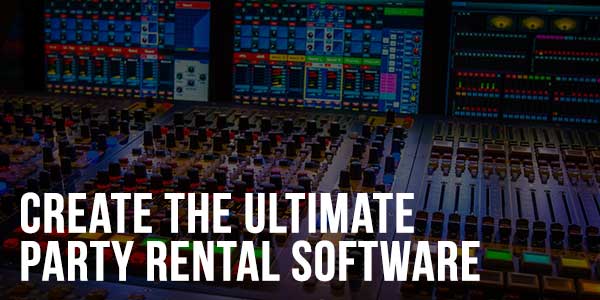
Are you passionate about the party rental business but have a tight budget? Fear not!
Starting a party rental business can be an exciting venture and having the right party rental software to manage your business can make all the difference.
The myth that circulates in the business is that you have to invest huge to get the extraordinary output.
But, the fact is you don’t have to invest huge. There are more business opportunities available where you can start your own business with no or less investment.
Let me tell you where you can create your party rental software for just $49.
Before diving into the development process, it’s crucial to define the specific requirements of your party rental software.
Table of Contents
Identify Your Party Rental Software Requirements:
Consider the core functionalities that your business needs, such as inventory management, booking systems, customer management, and reporting. By having a clear roadmap, you can streamline the development process and ensure that your software caters to the unique needs of your party rental business.
Keep requirements in mind and search for the best party rental software builder.
Choose The Best Platform To Build:
When working with a limited budget, it’s essential to choose a development platform that offers affordability without compromising functionality. No-code and low-code platforms have gained popularity for their user-friendly interfaces and cost-effective solutions.
No code platforms like QMarket provide powerful tools that allow you to build a party rental business software without extensive coding knowledge. Also, you can build a party equipment rental software for just $49.
Take the time to explore the pricing options of these platforms. Some offer free plans with limitations, while others provide budget-friendly subscription models.
Evaluate the features included in each plan and choose the one that aligns with your budget and project requirements.
Take Free Trial:
Once you’ve identified your requirements and selected a suitable platform like QMarket, it’s advisable to take advantage of any free trials they offer. Most no-code and low-code platforms provide a free trial period that allows you to test their features and functionalities before committing to a subscription.
During the trial period, focus on building a prototype or a small-scale version of your party rental business software to assess how well it meets your business needs. This will also allow you to evaluate the platform’s ease of use and whether it aligns with your technical proficiency.
Customize Your Party Rental Software:
Once you’ve chosen the platform and completed the trial, start customizing your party rental software according to your business requirements.
The design of your party rental booking software’s user interface is a critical aspect of its success. Use the built-in design tools of your chosen platform to create an intuitive and user-friendly interface.
Consider the user journey, making sure customers can easily browse available items, make bookings, and manage their accounts.
Pay attention to the placement of buttons, navigation menus, and overall layout. A well-designed UI enhances the overall user experience, making it more likely that customers will engage with your platform.
Keep the design consistent with your brand, incorporating elements that convey trust and reliability to potential users.
Integrate Essential Features:
A seamless and secure payment processing system is crucial for the success of your party rental booking software. Look for affordable payment processing options that integrate smoothly with your chosen platform.
Some no-code platforms offer built-in integrations with popular payment gateways, simplifying the process of accepting payments from your customers.
Ensure that the payment process is user-friendly, transparent, and complies with security standards. This step is vital in establishing trust with your customers and providing a hassle-free experience when completing transactions on your platform.
- Inventory Management: Keep track of your party rental items, including availability, quantity, and condition.
- Booking System: This allows customers to easily browse available items, check availability, and make reservations.
- Customer Management: Keep a database of customer information, including contact details, order history, and preferences.
- Reporting: Generate reports on sales, inventory turnover, and customer trends to make informed business decisions.
- Payment Processing: Integrate a secure payment gateway to accept online payments for reservations and orders.

Test And Debug:
Thorough testing is a critical phase in the development of any software, including your party rental business software.
To identify and fix any bugs or issues, conduct comprehensive testing of all functionalities. Enlist friends, colleagues, or even beta testers from your target audience to provide valuable feedback.
Testing should cover various scenarios, including different types of items, booking durations, and user interactions.
Pay attention to the reliability of the inventory management system, the accuracy of booking notifications, and the overall responsiveness of the platform. Iterative testing allows you to refine your software and ensure a smooth user experience.
Launch As MVP:
To minimize costs and time-to-market, consider launching a minimum viable product (MVP) of your party equipment rental software. An MVP includes the essential features that allow your platform to function and be tested by real users.
This approach enables you to gather valuable feedback, identify areas for improvement, and make necessary adjustments before investing more resources.
An MVP not only helps you validate your business idea but also allows you to establish an initial user base.
It’s an agile approach that aligns with the lean startup methodology, allowing you to adapt and evolve your party equipment rental software based on real-world usage.
Monitor And Iterate:
Building on the feedback received from your initial users, iterate on your party equipment rental software to enhance its features and address any shortcomings.
Regularly update and improve your software to stay competitive and meet the evolving needs of your users. Consider implementing new features based on user requests or industry trends.
The iterative process is an ongoing cycle of improvement. Pay attention to user analytics, customer support inquiries, and any emerging patterns in user behavior.
Use this data to make informed decisions about the next set of enhancements to keep your party rental software relevant and user-friendly.
As your budget allows, consider reinvesting profits into the development of advanced features.
This could include integrations with third-party services, additional customization options, or enhanced reporting capabilities. Gradually expanding the capabilities of your software will contribute to its long-term success.
In Conclusion:
Building party rental software on a $49 budget is undoubtedly a challenge, but with careful planning, strategic choices, and dedication, it’s an achievable goal.
This comprehensive guide has outlined the essential steps to create your party rental software, from defining requirements to marketing your platform effectively.
Embrace the journey of entrepreneurship, adapt to user feedback, and continuously seek ways to improve your software. As your business grows, consider allocating additional resources to further enhance and scale your party rental platform.
With perseverance and innovation, your affordable party rental software can become a valuable asset in the competitive event management industry. Cheers to your success!

 About the Author:
About the Author:
















Be the first to write a comment.